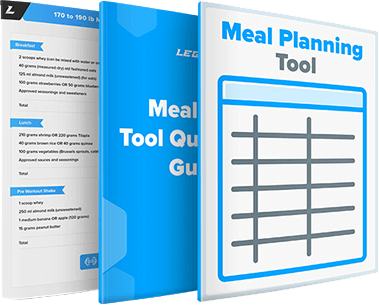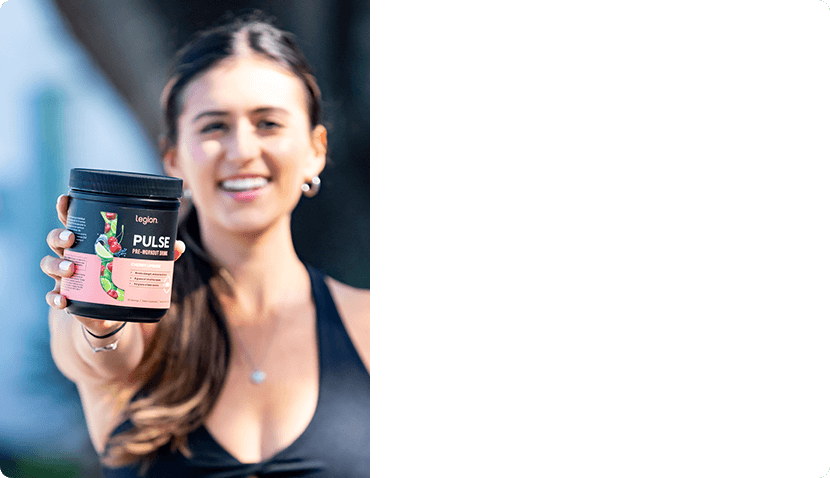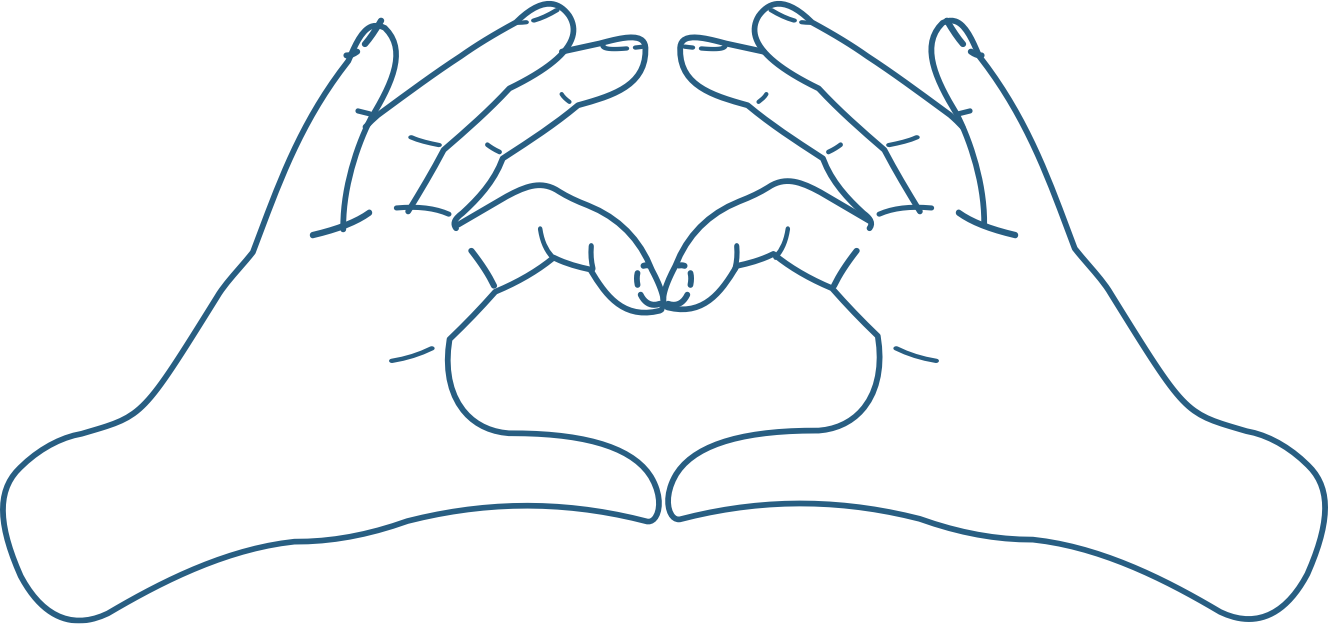
A well-structured push day is key for developing the strong, defined shoulders, chest, and triceps that shape your upper body.
But many push day workouts for women are either needlessly long or filled with exercises that look “fun” on social media but don’t actually move the needle.
You don’t need 12 different exercises or endless supersets, dropsets, and other “intensity techniques”—you need a handful of effective movements performed with enough effort, good technique, and steady progression.
This guide shows you exactly how to do that in about 45 minutes.
Key Takeaways
- A push day workout for women trains the chest, shoulders, and triceps—muscles that help shape your upper body.
- Most women get the best results from five exercises per push day: two chest, two shoulders, and one triceps movement.
- The best push day exercises for women are the incline dumbbell bench press, Arnold press, push-up, dumbbell side lateral raise, and triceps pushdown.
- To build muscle and definition, take most sets 1–2 reps short of failure and aim to increase weight or reps over time.
- You don’t need supplements to develop your chest, shoulders, and triceps, but protein powder, creatine, and pre-workout can help you get there faster.
Table of Contents
+
What Is a Push Day Workout for Women?

Push day workouts focus on training the main upper-body muscles involved in pushing things away from your torso—the chest, shoulders, and triceps.
They’re typically built around compound pressing exercises—like the bench press, push-up, and overhead press (or variations of them). These movements train multiple muscles at once and allow you to lift challenging weights safely and efficiently.
Most push workouts also include one or two isolation exercises to better target muscles that compound lifts don’t train as well—for example, side lateral raises for the side delts or triceps pushdowns for the triceps.
Push days are usually part of a “push pull legs” or “push pull legs upper lower” split, where each workout focuses on a different type of movement or area of the body. Organizing your workouts like this keeps your training balanced and ensures each muscle group gets trained and recovers on a predictable schedule.
To learn more about the most effective workout splits for women, check out this article:
The 3 Best Workout Splits for Women
What Do You Train on Push Day?
On push days, you train your . . .
- Pectorals (chest muscles)
- Deltoids (shoulder muscles)
- Triceps (the muscles on the back of your upper arms)
Here’s how those muscles look on your body:
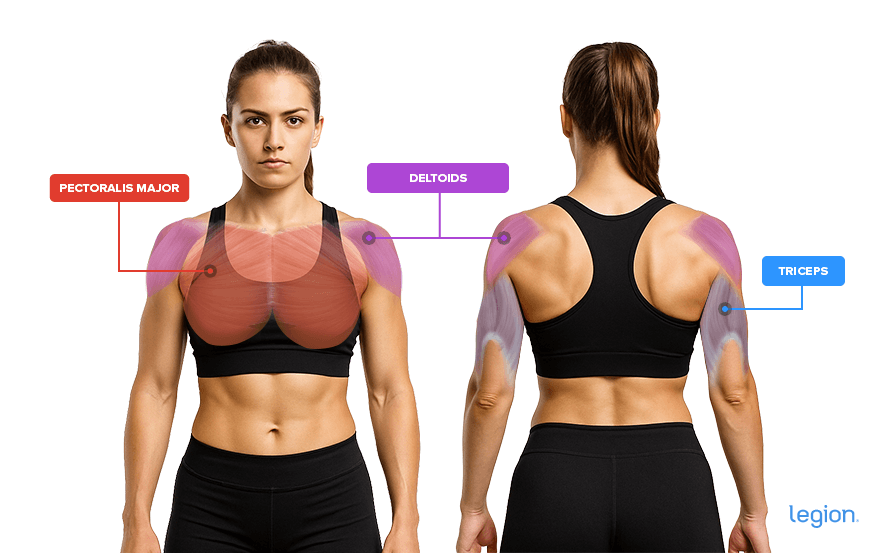
Push Day Warm-Up
If you feel stiff, begin your push day workout with a short general warm-up—3–5 minutes on a treadmill, elliptical, or some light arm circles and cross-body swings works well. If you already feel loose, skip straight to a more specific warm-up.
Here’s a research-backed protocol:
- Estimate the weight you’ll use for your first hard set of your first exercise.
- Do 6 reps with about 50% of that weight and rest for 1 minute.
- Do 4 reps with about 70% of that weight and rest for 1 minute.
After this, you’re ready to tackle your hard sets for your first exercise and the rest of your workout.
How Many Exercises Should You Do on a Push Day?
For most women, five exercises on a push day is ideal: two for your chest, two for your shoulders, and one for your triceps.
This provides enough hard sets to stimulate growth without piling on unnecessary fatigue, and keeps your workouts efficient—about 45 minutes start to finish.
Some programs call for six or seven exercises per push day. But having worked with thousands of women through Thinner Leaner Stronger and Legion’s body transformation coaching, I’ve consistently found that doing fewer exercises produces better results.
And if you’d like proof, here are a few coaching clients who built noticeably stronger, more defined shoulders, chest, and triceps in just a few months using this exact approach:

Complete 45-Minute Gym Push Day for Women
The following push-day workout is designed to help you sculpt strong, defined chest, shoulder, and triceps muscles.
It works because it focuses on push exercises that work best for women. Each one trains your pushing muscles through a full range of motion, allows you to lift challenging weights safely, and makes it easier to progressively increase strength over time.
The workout also provides just the right amount of volume (sets) to stimulate muscle growth without leaving you feeling worn out or keeping you in the gym for hours at a time.
That said, it is a challenging routine. To make sure you have the energy to tackle each workout, recover well, and build muscle effectively consider the following supplements:
- Pre-workout: A high-quality pre-workout enhances energy, mood, and focus, increases strength and endurance, and reduces fatigue.
- Creatine: Creatine boosts muscle and strength gain, improves anaerobic endurance, and reduces muscle damage and soreness from your push workouts.
- Protein powder: Protein powder, such as whey or casein, provides your body with the nutrients needed to build muscle tissue and recover from workouts.
Now let’s get to the workout:
1. Incline Dumbbell Bench Press

Muscles groups worked: Chest, shoulders, triceps
Why: The incline dumbbell bench press emphasizes the “upper pecs” and front delts, which adds definition around the collarbones and shoulders, enhancing how your upper-body looks from the front.
How to:
- Set your bench to a low incline (about 30–45°).
- Hold a dumbbell in each hand and sit back on the bench with the weights resting near your chest.
- Press the dumbbells up until your arms are straight.
- Reverse the movement and return to the starting position.
Expert Tip: Keep your shoulders safe by pulling your shoulder blades together and tucking them down toward your butt.
Sets, reps, and rest: 3 sets | 8–10 reps | 3–5 min rest
Alternatives:
2. Arnold Press
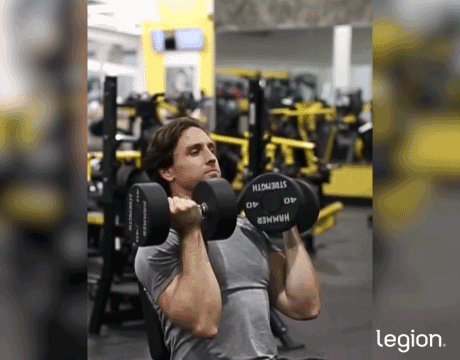
Muscles worked: Shoulders, triceps, upper back
Why: The Arnold press trains your side delts more than other overhead presses, which helps create a more rounded, “capped” shoulder look that enhances upper-body shape and balance.
How to:
- Sit on an upright bench and hold a dumbbell in each hand.
- Bring the dumbbells up in front of your shoulders with your palms facing you.
- Press the dumbbells overhead as you rotate your palms to face forward.
- Reverse the movement and return to the starting position.
Expert Tip: Protect your lower back by keeping your ribs down and bracing your core as you press the weights up.
Sets, reps, and rest: 3 sets | 8–10 reps | 3–5 min rest
Alternatives:
3. Push-up
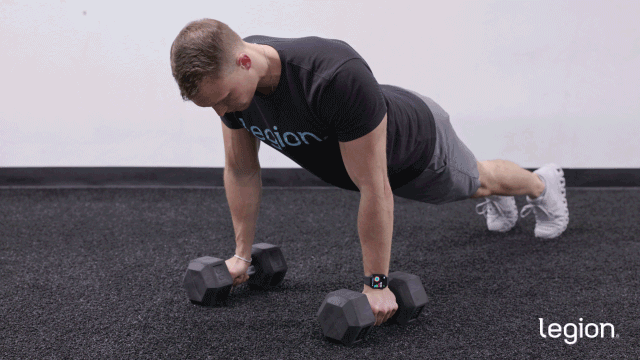
Muscles worked: Chest, shoulders, triceps
Why: Push-ups train your chest, shoulders, and triceps using just your body weight, which generally makes them easier on your joints than heavy pressing. They’re a great way to build strength and shape while keeping impact low.
How to:
- Start in a high plank with your hands slightly wider than shoulder-width.
- Lower your chest toward the floor by bending your elbows.
- Push back up to return to the starting position.
Expert Tip: If push-ups on your feet are too challenging right now, start with kneeling push-ups and work your way up.
Sets, reps, and rest: 3 sets | 8–10 reps | 3–5 min rest
Alternatives:
- Kneeling push-up
- Dumbbell bench press
- Barbell bench press
4. Dumbbell Side Lateral Raise

Muscles worked: Shoulders
Why: The dumbbell side lateral raise isolates the “side delts”, which is crucial for developing full, shapely shoulders.
How to:
- Stand up straight with a dumbbell in each hand.
- Raise the dumbbells out to your sides until your upper arms are parallel to the floor.
- Reverse the movement and return to the starting position.
Expert Tip: If this exercise bothers your shoulders, you may be lifting your arms too high. Raise them until they’re parallel with the floor, but no further.
Sets, reps, and rest: 3 sets | 8–10 reps | 2–3 min rest
Alternatives:
- Cable side lateral raise
- Barbell upright row
- Dumbbell upright row
5. Triceps Pushdown
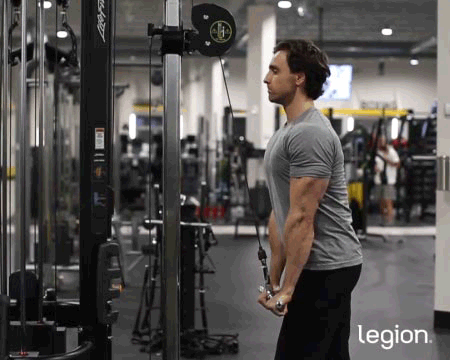
Muscles worked: Triceps
Why: The triceps pushdown develops all parts of the triceps, so it’s perfect for building defined upper arms.
How to:
- Set the cable to just above head height and attach the straight bar handle.
- Stand tall and hold the straight bar with both hands, palms facing the floor.
- Push the handle down by straightening your elbows.
- Reverse the movement and return to the starting position.
Expert Tip: To emphasize the triceps “long head” (the largest “section” of the triceps), let your elbows move slightly behind your torso.
Sets, reps, and rest: 3 sets | 8–10 reps | 2–3 min rest
Alternatives:
- Dumbbell overhead triceps extension
- Cable kickback
- Skullcrusher
How Often Should Women Do Push Day Each Week?
For most women, one push day per week is enough to make solid progress.
You can train your pushing muscles more often—and that may lead to slightly faster results—but doing so means you can’t devote as much training time and recovery resources to developing the muscles women typically want to emphasize: the legs and glutes.
And for most females, that’s not a worthwhile tradeoff.
READ MORE: The Best Training Frequency for Building Muscle (According to 20 Studies)
How to Progress Your Push Day
Progress is what drives muscle growth—if you don’t gradually challenge your muscles more over time, your upper body won’t get stronger or change shape.
There are two parts to progressing effectively:
1. Train Hard Enough
Finish most sets 1–2 reps shy of “failure”—the point where you can’t perform another rep with proper form even if you want to.
An easy way to gauge this is to ask yourself at the end of each set:
“If I had to, how many more reps could I have done with good form?”
If the answer is more than two, increase the weight or reps on your next set to make it more challenging.
2. Add Weight or Reps Over Time
If your workout calls for 8–10 reps of the Arnold press and you complete 10 reps in a set, increase the weight by 10 pounds (total) for your next set.
If you do 7 reps or fewer in subsequent sets, reduce the load by 5 pounds to stay in the 8–10 rep range.
Do this for every exercise, in every workout, and your upper body will continue to get stronger and more defined over time.
Safety & Form Basics for Push Movements
Here are a few simple tips and cues you can apply to most push exercises that help keep your shoulders, back, elbows, and wrists healthy:
Chest Exercises
To keep your shoulders safe and stable during the incline dumbbell bench press and push up:
- Pull your shoulder blades together: Think: “pinch a pencil” between your shoulder blades throughout each rep.
- Tuck your shoulder blades down: Once you’ve pulled them together, imagine “tucking them into your back pockets.”
- Tuck your elbows: Flare your elbows 6–8 inches from your ribcage at the bottom of each rep.
Shoulder Exercises
To keep your lower back safe while pressing weight overhead:
- Take a deep breath into your belly.
- Forcefully try to breathe out without letting air escape.
- Flex your abs as hard as you can.
Maintain this brace as you press and lower the weight, then reset your breath before your next rep. This is called the Valsalva maneuver, and while it’s especially important for exercises that “load” your spine, it’s good practice for basically every exercise.
Sample Weekly Split With Push Day Included
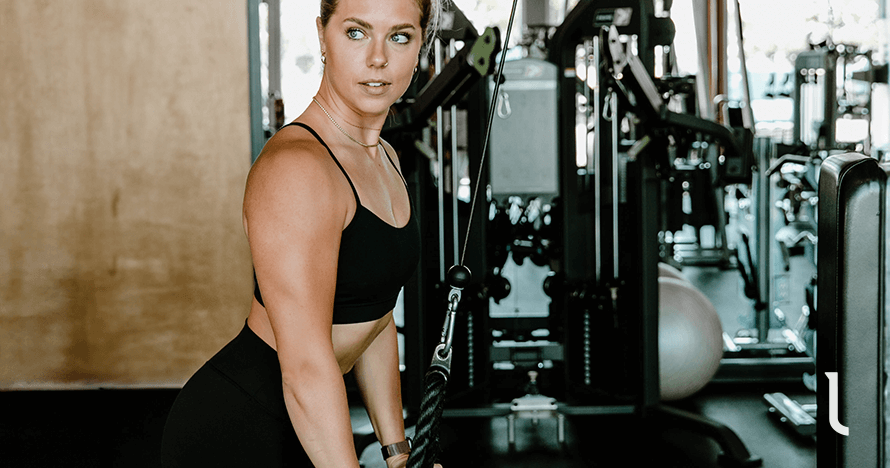
There are many ways to include a push day workout in a weekly split, but the following three schedules work best for most women.
3-Day PPL Split
- Monday: Push
- Tuesday: Rest
- Wednesday: Pull
- Thursday: Rest
- Friday: Legs
- Saturday: Rest
- Sunday: Rest
READ MORE: The Best Push Pull Legs Routines for Mass Gains
4-Day Upper Lower Split
- Monday: Push
- Tuesday: Lower
- Wednesday: Rest
- Thursday: Pull
- Friday: Lower
- Saturday: Rest
- Sunday: Rest
READ MORE: The Best Upper Lower Split Workouts for Mass & Strength
5-Day PPLUL
- Monday: Push
- Tuesday: Pull
- Wednesday: Legs
- Thursday: Upper
- Friday: Lower
- Saturday: Rest
- Sunday: Rest
READ MORE: An Expert Guide to the Push Pull Legs Upper Lower (PPLUL) Split
The Bottom Line on Push Day Workouts for Women
A well-designed push day routine helps you build strong, defined chest, shoulder, and triceps muscles that improve upper-body shape and balance.
You don’t need endless variations or marathon sessions to get results—just train hard, strive to get stronger over time, and repeat this workout once per week as part of a balanced routine. Do that consistently, and you’ll have no trouble developing a sculpted upper body.
FAQ #1: Should women do push day?
Yes. Push day workouts for women are an effective way to build balanced upper-body muscle and strength. When done alongside effective lower-body training, it helps create a strong, balanced physique.
FAQ #2: What do you work out on push day?
You train the main muscles involved in pushing movements: your chest (pectorals), shoulders (deltoids), and triceps.
These muscles work together whenever you press weight away from your body, like in bench presses, overhead presses, and push-ups. A push day focuses on strengthening all three in one efficient workout.
FAQ #3: How many exercises should I do on a push day?
Most women do best with five exercises per push day: two for your chest, two for your shoulders, and one for your triceps. This provides enough training to stimulate muscle growth without adding unnecessary fatigue or turning your workout into a long, draining session.
FAQ #4: How often should I train push day each week?
For most women, once per week is enough to make consistent progress. You can train push day more often, but doing so usually means taking time and recovery away from the muscles most women want to emphasize—the legs and glutes.
In other words, one session per week keeps your upper body developing without interfering with lower-body gains.
FAQ #5: Can I do push day at home without machines?
Yes. You can do an effective push day at home with just dumbbells or even body weight. Exercises like decline push-ups, regular push-ups, dumbbell shoulder presses, lateral raises, and overhead triceps extensions all work well.
For example, here’s a routine you could follow with just a set of dumbbells:
- Decline Push-up: 3 sets | 8–10 reps | 3–5 min rest
- Arnold Press: 3 sets | 8–10 reps | 3–5 min rest
- Push-up: 3 sets | 8–10 reps | 3–5 min rest
- Dumbbell Side Lateral Raise: 3 sets | 8–10 reps | 2–3 min rest
- Overhead Triceps Extension: 3 sets | 8–10 reps | 2–3 min rest
Want More Content Like This?
Check out these articles:
- The Ultimate 3-Month Female Body Recomposition Workout Plan
- Transform Your Pear-Shaped Body: Exercises & Diet Tips
- The Best Hourglass Body Workout Routine for a Slim Waist & Big Curves
Scientific References +
- Ribeiro, Bruno, et al. “The Role of Specific Warm-up during Bench Press and Squat Exercises: A Novel Approach.” International Journal of Environmental Research and Public Health, vol. 17, no. 18, 22 Sept. 2020, p. 6882, pmc.ncbi.nlm.nih.gov/articles/PMC7558980/, https://doi.org/10.3390/ijerph17186882.
- Eckerson, Joan M., et al. “Effect of Creatine Phosphate Supplementation on Anaerobic Working Capacity and Body Weight after Two and Six Days of Loading in Men and Women.” The Journal of Strength and Conditioning Research, vol. 19, no. 4, 2005, p. 756, https://doi.org/10.1519/r-16924.1.
- Bassit, Reinaldo Abunasser, et al. “Effect of Short-Term Creatine Supplementation on Markers of Skeletal Muscle Damage after Strenuous Contractile Activity.” European Journal of Applied Physiology, vol. 108, no. 5, 3 Dec. 2009, pp. 945–955, https://doi.org/10.1007/s00421-009-1305-1.
- Stokes, Tanner, et al. “Recent Perspectives Regarding the Role of Dietary Protein for the Promotion of Muscle Hypertrophy with Resistance Exercise Training.” Nutrients, vol. 10, no. 2, 7 Feb. 2018, p. 180, www.mdpi.com/2072-6643/10/2/180/pdf.
- Raizada, Shiny, and Amritashish Bagchi. “Comparison among the EMG Activity of the Anterior Deltoid and Medial Deltoid during Two Variations of Dumbbell Shoulder Press Exercise.” Indian Journal of Public Health Research & Development, vol. 8, no. 4, 2017, p. 653, https://doi.org/10.5958/0976-5506.2017.00411.9.
- Kholinne, Erica, et al. “The Different Role of Each Head of the Triceps Brachii Muscle in Elbow Extension.” Acta Orthopaedica et Traumatologica Turcica, vol. 52, no. 3, 1 May 2018, pp. 201–205, www.ncbi.nlm.nih.gov/pmc/articles/PMC6136322/, https://doi.org/10.1016/j.aott.2018.02.005.
- Schoenfeld, Brad J., et al. “Effects of Resistance Training Frequency on Measures of Muscle Hypertrophy: A Systematic Review and Meta-Analysis.” Sports Medicine, vol. 46, no. 11, 21 Apr. 2016, pp. 1689–1697, pubmed.ncbi.nlm.nih.gov/27102172/, https://doi.org/10.1007/s40279-016-0543-8.
- Er, Helms, et al. “Recommendations for Natural Bodybuilding Contest Preparation: Resistance and Cardiovascular Training.” The Journal of Sports Medicine and Physical Fitness, 1 Mar. 2015, pubmed.ncbi.nlm.nih.gov/24998610/.

